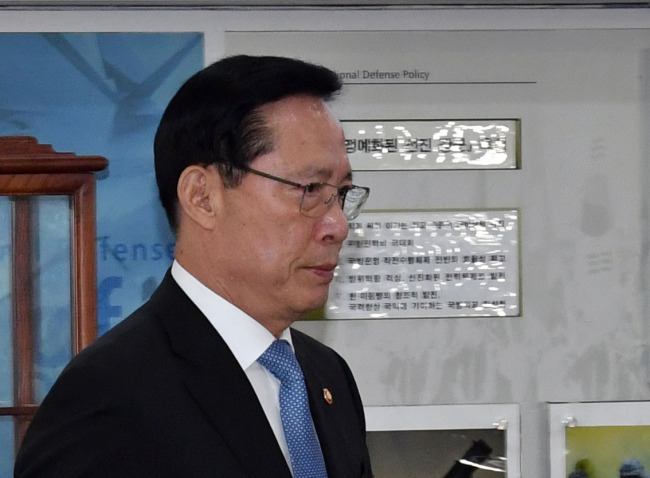Defense reform plan focuses on organizational change
Long-delayed plan lacks specific measures against NK military threat
By Yeo Jun-sukPublished : July 29, 2018 - 16:43
The defense reform plan announced last week aims to overhaul the military’s command systems and troop organization amid the country’s growing need to adapt to the changing security landscape and the demographic shift.
However, the plan lacks specific measures for changing the operational scheme in the event of a war with North Korea, which had been expected to be incorporated into the reform blueprint since the military floated the idea last year.
The Ministry of National Defense on Friday unveiled a long-awaited defense reform plan after briefing President Moon Jae-in. Defense Minister Song Young-moo said the plan focused on enhancing civilian control over the military and striking a balance among different service branches.
“The defense reform plan’s ultimate goal is to establish a democratic, advanced military structure,” Song said during a press briefing. “I’m going to push for the defense reform plan with commitment to creating a new military under a new era.”
Among the key structural changes is replacing the current US-led Combined Forces Command with one led by South Korea. Under the reform blueprint, South Korea’s chairman of Joint Chiefs of Staff is expected to assume the role of commander, while the US general serves as the deputy.
The Defense Ministry will also create a new Ground Operational Command next year by integrating the1st and 3rd Field Army Commands. The integrated command is to be activated on Jan 1, 2019.
Regarding the Air Force and Navy, a new reconnaissance wing will enhance the Air Forces’ capabilities for long-distance and space operations, while the Navy will expand its maritime task flotilla and aviation wing to secure capabilities for surface, underwater and aerial operations.
“In order to address various threats from diverse dimensions, we will realign our forces’ structure to allow for prompt response against enemies. … Our focus is on developing a future-oriented military structure in line with advanced scientific technology,” the Defense Ministry said in a statement.

In an effort to streamline the force structure, the ministry said it would reduce the number of active-duty troops to 500,000 by 2022 from the current 618,000. The number of generals will be cut from 436 to 360 in line with the overall troop drawdown.
The reform plan also includes a measure to reduce the mandatory military service period. By 2021, the military aims to cut the service period in the Army and Marines from 21 months to 18 months, in the Navy from 23 to 20 and in the Air Force from 24 to 20.
The ministry also said it would mandate the Army, the Navy and Air Force to equally share core decision-making positions at the Joint Chiefs of Staff, whose top brass has been dominated by Army generals during previous conservative governments.
“The number of JCS positions assumed by the Army is twice as many as those from the Navy and the Air Force. … It has posed a challenge for inter-service cooperation in the new combat environment,” the ministry said.
While the ministry pledged to continue its efforts to establish the “three-layered system” against North Korea’s missile and nuclear threats the reform blueprint did not include the military’s envisioned plan of a more aggressive wartime operational plan.
The military will proceed with building the three-layered system by mid-2020. The scheme consists of the Kill Chain pre-emptive strike system, the Korea Air Missile Defense system and Korea Massive Punishment and Retaliation plan aimed at North Korea’s leadership.
The military’s efforts to adopt a new Aggressive Operational Plan was left out in the latest defense reform plan. The military had envisioned a more aggressive operational plan against North Korea, under which the military secures Pyongyang within a few weeks after a war.
“Aggressive operational scheme is more of a tactical issue … so it is difficult to explain in the defense reform plan, which deals with laying out a broad concept of the military’s force structure,” a military official told reporters under the customary condition of anonymity.
By Yeo Jun-suk (jasonyeo@heraldcorp.com)








![[Kim Seong-kon] Democracy and the future of South Korea](http://res.heraldm.com/phpwas/restmb_idxmake.php?idx=644&simg=/content/image/2024/04/16/20240416050802_0.jpg&u=)







![[KH Explains] Hyundai's full hybrid edge to pay off amid slow transition to pure EVs](http://res.heraldm.com/phpwas/restmb_idxmake.php?idx=652&simg=/content/image/2024/04/18/20240418050645_0.jpg&u=20240418181020)

![[Today’s K-pop] Zico drops snippet of collaboration with Jennie](http://res.heraldm.com/phpwas/restmb_idxmake.php?idx=642&simg=/content/image/2024/04/18/20240418050702_0.jpg&u=)